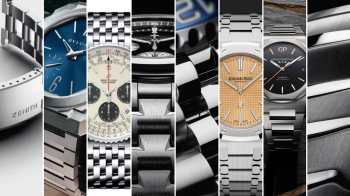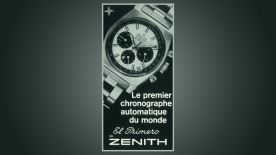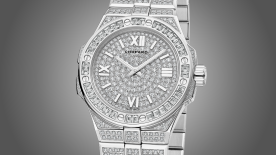Never before has it been so important. The steel bracelet is flourishing, nurtured by the explosion of the casual chic style. Yet it is a complex art, in which it is difficult to do things well and get noticed.

A strap or bracelet represents 70% of the contact surface between watch and skin. This proportion alone might be enough to sum up the crucial importance of the design of metal bracelets, but it definitely makes them even more complex and demanding to make. This little-known art, which takes a back seat to the general aesthetics of the case and mechanics, is nevertheless fundamental. It is an essential and often neglected determining factor in the quality, comfort and design of the watch. While one does not choose a model for its bracelet, it can easily be a turn-off for potential enthusiasts with regards to a model they would otherwise find magnificent. It is therefore a question of design, but also of the delicate, subterranean logic of ergonomics and comfort. A good bracelet can be appreciated as much with the skin as with the eye.
Define
The parameters of a metal bracelet are extremely numerous. First of all, the shape of the link: flat or curved? According to which curvature? Wide or narrow? Solid or folded? Polished, satin-finished, or a bit of both? How are its edges treated: sharp or very beveled edges? What is their degree of articulation and especially that of the first links, which create the radius of curvature around the wrist? How many do you want: 1, 3, 5, or even 7 and sometimes 9? What is its clasp like: two or three blades? Fitted with a protective cover or invisible? Is it integrated into the case, or visibly separated from it? Finally, in the particular case of the Milanese mesh, is it fixed to the case by a straight hollow bar containing a spring bar, or with a rounded edge that follows the curve?
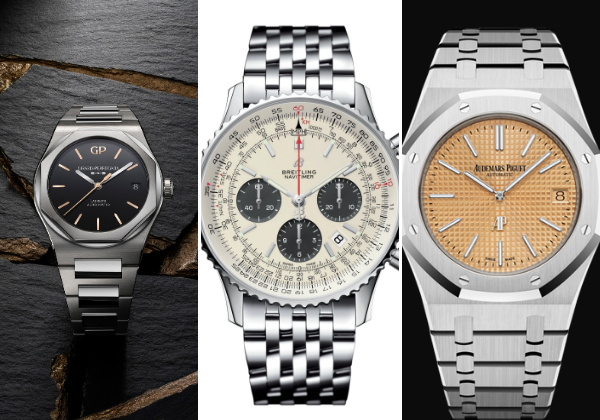
Exist
Creating a metal bracelet means answering all these questions. Based on this array of choices, one can decipher what emerges from designers’ imagination. Yet their greatest constraint lies elsewhere, because when it comes to bracelets, one has to innovate in order to exist. And the spectrum has already been significantly explored. There are countless recognizable creations that connoisseurs are able to attribute to a given brand or even the original model. Witness the fabled classic Rolex Oyster bracelet, as well as the more precious Jubilee with its central small curved links. The Breitling Navitimer with its oblique alignment. The Octo’s very large single link, articulated by means of a smaller inner section. The unmistakable Royal Oak plate with its two vertical pins. The polished plate in the middle of the large matt link of the Laureato by Girard-Perregaux, a variant on the same theme as the Nautilus…
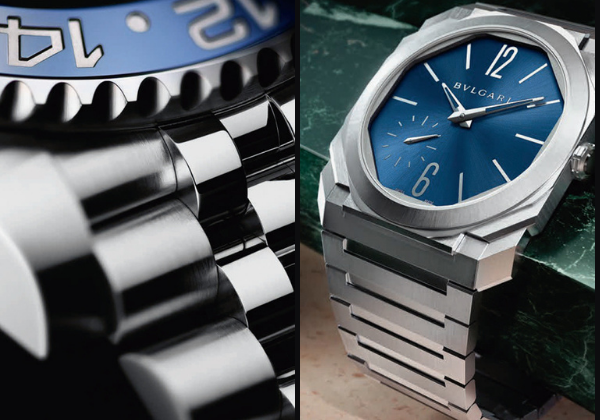
Invent
Nonetheless, imaginations have been unleashed and new shapes have emerged in an age of casual wear, distance working and gender fusion. The stakes have never been higher, because any brand that does not have its own sporty chic range is in danger of becoming irrelevant. That is how the organic shape that holds the Streamliner from H. Moser & Cie. to the wrist was born. Complex, rounded, three-dimensional links, with finishes that are terribly difficult to execute. At Vacheron Constantin, the initial principle of the Overseas has been taken up again, with the link derived from its Maltese cross emblem flattened and trimmed for the new generation. The same is true at Tudor, which has dedicated an entirely new integrated bracelet to the Royal line, but whose roots lie in previous executions. It is, moreover, a movement typical of the sporting style, which is resulting in numerous ‘resurrections’: Zenith based its El Primero Revival A384 on a so-called ladder-link bracelet, formerly manufactured by the specialist in this field, Gay Frères.

Touch And Feel
Metal bracelets are therefore a distinctive design element. Yet behind the logic of affirming identity, wearer comfort remains key – and the best-known examples are not always the most impressive in terms of their ergonomics. The importance of the links’ degrees of rotation, inner finish and weight is often underestimated. It is these factors that speak directly, secretly, to the customer during the first contact that really counts; that wonderful moment when one first slips a given watch onto the wrist.
*On the occasion of GMT Magazine and WorldTempus' 20th anniversary, we have embarked on the ambitious project of summarising the last 20 years in watchmaking in The Millennium Watch Book, a big, beautifully laid out coffee table book. The Millennium Watch Book is available on www.the-watch-book.com, in French and English.
